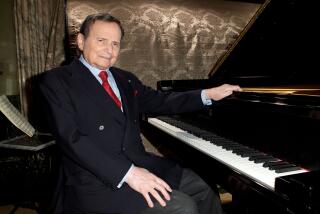Renowned Soviet Concert Pianist Emil Gilels Dies at 68
- Share via
Emil Gilels, one of a select group of musicians credited with placing the Soviet Union among the world’s premier artistic locales, has died in Moscow.
Wilfred Stiff, the concert pianist’s British agent, said Tuesday in London that Gilels had died at age 68 and that his death on Monday was attributed to heart problems that had curtailed his appearances in recent months.
With Sviatoslav Richter, David Oistrakh and Mitislav Rostropovich, Gilels surfaced in the world’s concert halls shortly after the end of World War II and was accorded widespread praise for his touch and color.
From Bach to Bartok
With a repertoire that ranged from Bach to Bartok, Gilels attracted a loyal following around the world via the fledgling cultural exchange programs prevalent in Europe and the United States and through his recordings for Angel and RCA Victor.
Gilels, along with the Bolshoi Ballet, portions of the Moscow circus and the Moiseyev folk dancers, became carefully orchestrated symbols to the Western world, helping the Kremlin establish that they ruled both a powerful and an aesthetic nation.
The rusty-haired, deadpan Gilels would use his limited English to explain to Western reporters that he not only had entertained Nikita S. Khrushchev but had done it on an American piano--a Steinway.
Born in Odessa on the Black Sea, he was only 5 when admitted to the prestigious Odessa Institute of Music and Drama and eight years later gave what accounts of that day described as a “sensational” first recital.
Gilels quickly established a reputation for scholarship coupled with physical strength. His appearance--because of his stubby fingers and barely manageable hair--was likened to a peasant rather than a serious artist.
By age 16 he had won a national Soviet piano competition and then moved from the Odessa to the Moscow Conservatory where he did graduate work under Gendrich Neihaus, one of Russia’s foremost musicologists.
In 1938 Gilels won his first international blue ribbon at the Ysaye International Festival in Brussels. He had been engaged for the 1939 World’s Fair in New York, but World War II intervened and he spent the next seven years performing in Russia.
After the war he performed in Italy, Switzerland, Denmark and France and in 1955 became the first well-known Soviet musician to play in the United States, where his New York debut was praised for its diversity and sensitivity.
Gilels’ travels came to be a bellwether of Soviet-American political relations. If Khrushchev could tour Hollywood, Gilels could play at Carnegie Hall. But if Israel or Vietnam or Afghanistan were dominating the world scene, then the pianist would be kept at or near home.
His limited appearances usually were before sold-out houses in the United States, as was his initial visit to the West Coast in 1958 when he performed Scarlatti, Beethoven, Debussy and Stravinsky at Los Angeles’ Philharmonic Auditorium.
At UCLA in 1979
He was not seen in America from 1979, when he played Schumann at UCLA’s Royce Hall, to 1983 when he performed Brahms at New York’s Carnegie Hall. His surprise concert there led a New York Times critic to speculate that the KGB and the CIA had “made a secret deal.”
Unlike his compatriot, Richter, Gilels was praised more for his nuances than his technique and concert-goers became accustomed to his occasional slips or unusual interpretations of tempo.
He was a pianist, Los Angeles Times critic Arthur Goldberg once wrote, who “indulged his flair both for thunderous virtuosity and for songful tonal manipulation.”
More to Read
The biggest entertainment stories
Get our big stories about Hollywood, film, television, music, arts, culture and more right in your inbox as soon as they publish.
You may occasionally receive promotional content from the Los Angeles Times.










